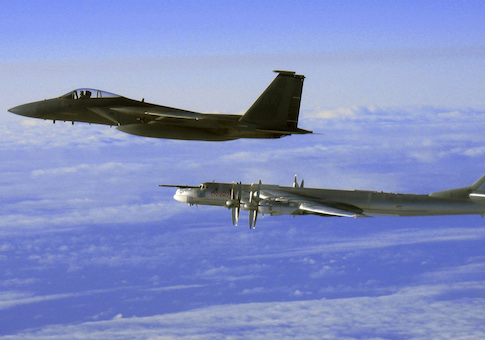Russian strategic bombers conducted a third circumnavigation of the U.S. Pacific island of Guam last week as other bombers flew close to Alaska and Europe, defense officials said.
Two Tu-95 Bear H bombers made the flight around Guam, a key U.S. military hub in the western Pacific, on Dec. 13. No U.S. interceptor jets were dispatched to shadow the bombers.
Separately, two Canadian F-18s intercepted two Bear bombers that intruded into the Alaska air defense identification zone on Dec. 8 that a military spokesman called "unwanted, provocative, and potentially destabilizing."
Around the same time in Europe, NATO jets intercepted Russian Tu-95 and Tu-22 Backfire bombers also conducting provocative flights.
Russian warplanes, including four Bear Hs and two Tu-22M Backfire bombers were shadowed as they flew simulated bombing runs from bases in Russia to the Baltic Sea enclave of Kaliningrad for four days beginning on Dec. 7.
Regarding the Guam air defense zone incursions, "U.S. Pacific Command can confirm that two aircraft entered Guam's outer air defense identification zone on Dec. 13," said Maj. Dave Washburn, a command spokesman.
"The aircraft were flying safely in international airspace and in accordance with international norms; as such, the decision was made to not intercept them."
It was the second time in a month that nuclear-capable Russian bombers buzzed the island in what U.S. officials have said is nuclear saber-rattling by Russia under its strongman Vladimir Putin.
Earlier Russian bomber flights around the 36-mile-long island took place in November and on Feb. 12, 2013. During the 2013 incursion, F-15 jets were scrambled to intercept the part of bombers.
Both earlier flights were timed to political events, including President Obama’s meeting with Putin in Australia and the president’s state of the union message in 2013.
The latest bomber flights near Guam appear timed to the Obama administration’s plan for imposing additional economic sanctions on Russia for its military annexation of Ukraine’s Crimea and continuing destabilization operations in eastern Ukraine.
Russian Foreign Minister Sergei Lavrov told Secretary of State John Kerry during a phone call Friday that new U.S. sanctions will damage U.S.-Russia relations.
In the Alaska incident, two bombers were flying northwest of Anchorage and into the Beaufort Sea off of the Canadian coast, said Navy Capt. Jeff A. Davis, a spokesman for the North American Aerospace Defense Command and U.S. Northern Command.
Davis said the Russian bombers entered both the Alaska air defense identification zone and the Canadian air defense identification zone, but did not enter sovereign U.S. or Canadian airspace.
"While we recognize the need for routine military training activity, we have noticed an increase in the number of these flights near North America in recent months since Russia’s incursion into Ukraine and Crimea," Davis said.
Foreign aircraft are not required to file flight plans in advance of flights through defense zone, however, "such unannounced operations by strategic bombers near the U.S. and Canada are unwanted, provocative, and potentially destabilizing," he stated.
Davis said Russian long-range bomber flights around North America "largely ceased" after the collapse of the Soviet Union in 1991.
"But they restarted in 2007," he said. "Since 2007, Norad fighters have conducted intercepts about five times per year of Russian long-range bombers in the U.S. or Canadian air defense identification zones."
Shirley A. Kan, a Congressional Research Service analyst, stated in a report made public Nov. 27 that Guam is a key element in the Obama administration’s shift to Asia.
"Guam is critical to enhancing the forward presence, strengthening alliances, and shaping China’s rise," Kan stated.
The U.S. territory is about 3,800 miles west of Hawaii and includes 160,000 people including 6,000 military personnel.
The Pacific Command beginning in 2000 started "to build up air and naval forces on Guam to boost U.S. deterrence and power projection in Asia," Kan said.
The U.S. Army deployed its newest missile defenses to Guam last year. The terminal high-altitude area defense battery, or THAAD, is based on Andersen Air Force Base.
The Navy also has deployed three attack submarines on Guam.
The island is also a major electronic intelligence-gathering base.
Deputy Defense Secretary Bob Work said during a visit to the island in August that "Guam has always been a central part of our plans" for shifting military forces to the region.
The Air Force frequently deploys both B-2 and B-52 strategic bombers and fighter aircraft, along with long-range Global Hawk drones.
Around 5,000 Marines now based on Okinawa are slated to be moved to Guam.
THAAD is a land-based element that can shoot down a ballistic missile inside and just outside the atmosphere. It uses hit-to-kill technology: Kinetic rather than explosive energy destroys the incoming warhead.
Bear H bombers are relatively old aircraft. They carry Kh-55SM cruise missiles armed with nuclear or conventional warheads. The missile has a range of up to 1,800 miles.
The Russian flights over the Baltic "represented a significant level of activity by Russia," NATO Spokeswoman Oana Lungescu told Agence France Presse.
"Such activity can be destabilizing and potentially dangerous, if international norms are not respected," Lungescu said.
NATO Secretary General Jens Stoltenberg has said alliance jets conducted about 400 intercepts of Russian aircraft this year, a 50 percent increase over last year.
